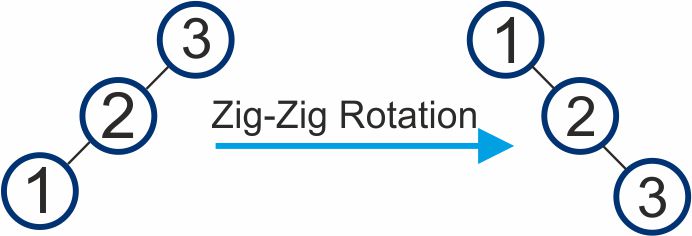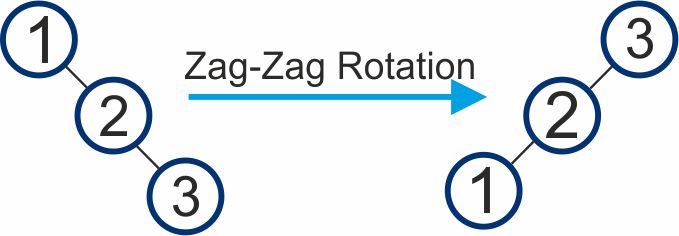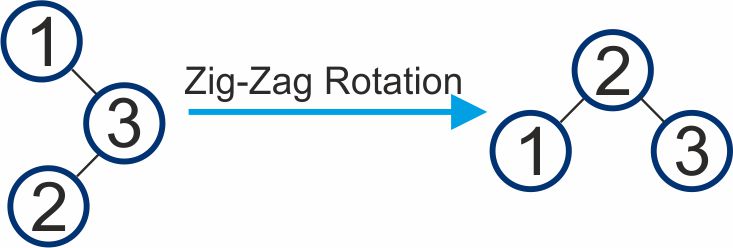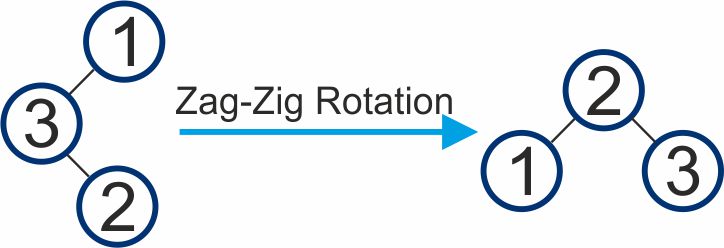Splay Tree
The splay tree was developed by Daniel Dominic Sleator and Robert Endre Tarjan in 1985. A Splay Tree is a self-adjusting binary search tree data structure that automatically reorganizes itself to optimize access times for frequently accessed elements by moving them closer to the root. It accomplishes this by performing a splay operation after every search, insert, or delete operation, bringing the accessed node to the root of the tree.
Key Features of Splay Trees
- Self-Adjusting: After any operation, the accessed node is splayed to the root of the tree, making it the new root. This helps improve the access time for frequently accessed elements.
- No Height Balance Guarantee: Unlike AVL trees and Red-Black trees, Splay Trees do not guarantee a balanced height. However, they exhibit a form of local balance, which means nodes that are frequently accessed tend to move closer to the root.
Splay Tree Rotations:
Splay Trees use rotations to perform the splay operation and bring the accessed node to the root.
Zig Rotation(Right)
- This rotation moves a child node up and its parent node down, making the child the new parent.
- It is used when the target node is the right child of its parent.

Zag Rotation(Left)
- Similar to the zig rotation, the zag rotation moves a child node up and its parent node down, but the child becomes the left child of the new parent.
- It is used when the target node is the left child of its parent

Zig – Zig Rotation
- In a Zig-Zig rotation, two consecutive rotations are performed to move a node up two levels closer to the root.
- The first rotation moves the target node's grandchild up and its child down.
- The second rotation moves the target node up and its previous grandchild down.
- It is used when the target node is the right child of the right child of its parent.

Zag – Zag Rotation
- In a Zag-Zag rotation, two consecutive rotations are performed to move a node up two levels closer to the root.
- This rotation is similar to the zig-zig rotation but involves two consecutive zag rotations.
- It is used when the target node is the left child of the left child of its parent.

Zig – Zag Rotation
- In a Zig-Zag rotation, two consecutive rotations are performed to move a node up one level closer to the root.
- This rotation combines a zig rotation followed by a zag rotation.
- It is used when the target node is the right child of the left child of its parent.

Zag – Zig Rotation
- In a Zag-Zig rotation, two consecutive rotations are performed to move a node up one level closer to the root.
- This rotation performs a zag rotation followed by a zig rotation.
- It is used when the target node is the left child of the right child of its parent.

Insertion in a Splay Tree:
Pseudocode
procedure splayInsert(root, key):
if root is null:
// Create a new node with the given key and make it the root
root = createNode(key)
else:
// Perform a normal BST insertion
root = bstInsert(root, key)
// Splay the newly inserted node to the root
root = splay(root, key)
function bstInsert(node, key):
// Standard BST insertion procedure
if node is null:
return createNode(key)
if key < node.key:
node.left = bstInsert(node.left, key)
else if key > node.key:
node.right = bstInsert(node.right, key)
return node
function splay(root, key):
if root is null or root.key == key:
return root
// Key is in the left subtree
if key < root.key:
// Key is not in the tree, return the unchanged root
if root.left is null:
return root
// Zig-Zig step: Left-left case
if key < root.left.key:
root.left.left = splay(root.left.left, key)
root = rightRotate(root)
// Zig-Zag step: Left-right case
else if key > root.left.key:
root.left.right = splay(root.left.right, key)
if root.left.right is not null:
root.left = leftRotate(root.left)
// Perform a final rotation to bring the key to the root
if root.left is not null:
root = rightRotate(root)
return root
// Key is in the right subtree
else:
// Key is not in the tree, return the unchanged root
if root.right is null:
return root
// Zig-Zig step: Right-right case
if key > root.right.key:
root.right.right = splay(root.right.right, key)
root = leftRotate(root)
// Zig-Zag step: Right-left case
else if key < root.right.key:
root.right.left = splay(root.right.left, key)
if root.right.left is not null:
root.right = rightRotate(root.right)
// Perform a final rotation to bring the key to the root
if root.right is not null:
root = leftRotate(root)
return root
function rightRotate(node):
// Right rotation operation
newRoot = node.left
node.left = newRoot.right
newRoot.right = node
return newRoot
function leftRotate(node):
// Left rotation operation
newRoot = node.right
node.right = newRoot.left
newRoot.left = node
return newRootDeletion in a Splay Tree:
Pseudocode
procedure splayDelete(root, key):
if root is null:
// Key not found, return the unchanged root
return root
// Splay the node containing the key to the root
root = splay(root, key)
// After splaying, if the key is not at the root, it's not in the tree
if key != root.key:
return root
// Perform the actual deletion
if root.left is null:
return root.right
else:
// Find the maximum node in the left subtree
maxNode = findMax(root.left)
// Splay the maximum node to the root of the left subtree
root.left = splay(root.left, maxNode.key)
// Attach the right subtree as the right child of the maximum node
maxNode.right = root.right
return maxNode
function findMax(node):
// Find the maximum node in a subtree
while node.right is not null:
node = node.right
return nodeSearching in a Splay Tree
Pseudocode
function splaySearch(root, key):
if root is null:
// Key not found, return null or a sentinel value
return null
// Start searching from the root
while root is not null:
if key == root.key:
// Key found, splay the node to the root
return splay(root, key)
else if key < root.key:
// Key is in the left subtree
if root.left is null:
// Key not found, splay the last accessed node (root)
return splay(root, key)
// Continue searching in the left subtree
root = root.left
else:
// Key is in the right subtree
if root.right is null:
// Key not found, splay the last accessed node (root)
return splay(root, key)
// Continue searching in the right subtree
root = root.right
// Key not found, return null or a sentinel value
return nullNext Topic :B Tree
